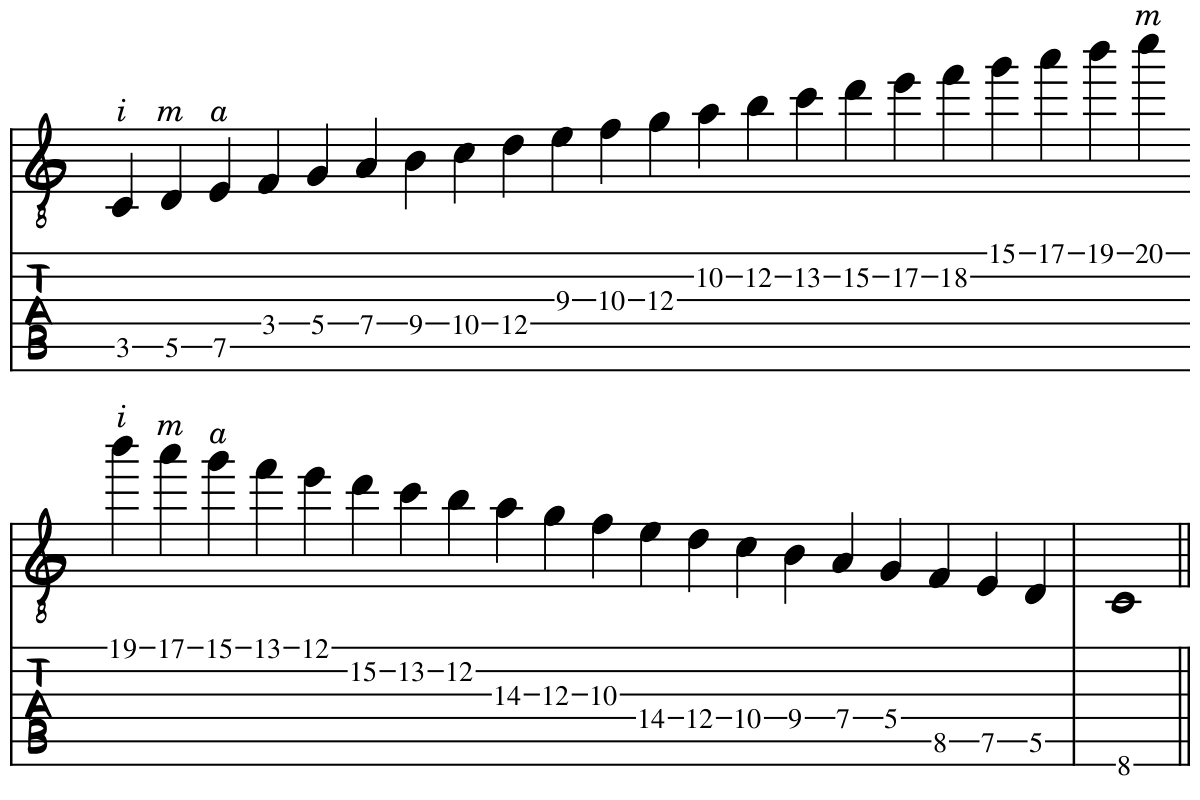Here are 7 excellent scales you can use to warm up your playing.
Scales are probably the most well-known warm-up for all instruments, stringed, blown or otherwise.
But on the guitar, not all scales are easy or contain obvious finger patterns. In fact, an easy C Major or G Major scale on the piano can be more difficult on the guitar due to the layout of notes on the guitar neck being not as straightforward as, say, the keys on the piano.
So I'm going to share with you 7 scales that you can use as a warm up. Remember as a fingerstyle guitar player, you'll want to pay attention not only to the fretting hand, but the plucking hand fingering pattern as well.
7 Best Scales For Fingerstyle Guitarists To Use As A Warm Up
Here are the seven scales that you can play as your next fingerpicking warm up, going from easiest to trickiest.
- The A Minor Pentatonic Scale
- The Chromatic Scale
- The Double Harmonic Major Scale
- The A Minor Harmonic Scale
- The C Major Scale
- The Whole Tone Scale
We'll start with the easiest and most well-known scale for guitarists, the minor pentatonic scale in A.
The A Minor Pentatonic Scale
Like any pentatonic, the A minor pentatonic scale contains five notes and is simpler to play than the major scale. The pentatonic "box pattern" is very straightforward to play on the guitar. It's also a classic scale used in guitar solos found in Rock music.
The pentatonic scale uses a very simple finger picking pattern. Since there are only two notes per string, you can alternate between using your index and your middle fingers to pluck the strings. The finger pattern for the minor pentatonic scale is simple and there are no position changes.

I love the sound of the pentatonic scale. Unfortunately, once you get past a certain point in your guitar playing, practicing the pentatonic scale gets a little boring. Let's continue with a scale that is super easy to memorize and uses all the fingers.
The Chromatic Scale
The chromatic scale is what we get when playing all the notes on the guitar that are between the octave. The chromatic scale on the guitar contains four notes per string.
To perform the chromatic scale on the guitar, start at any note on the sixth string. Play each fretted note with each of the fingers, then switch to the following string, shifting the hand downwards by one position. For example, if you were to start on the seventh fret, play the frets 7,8,9,10 and then on the following string you would play frets 6,7,8 and 9.
You'll learn more about shifting and position changes in my online course, Play Fingerstyle Guitar Now!
The exception to this fingering pattern occurs when you reach the third string. After playing four notes in a row on the third string, you do not need to shift the hand backwards to continue the chromatic pattern on the second string. Instead, you continue the four notes without shifting.
We noticed with the major scale that there are "gaps" in the scale notes, caused by the unequal distance between the notes. The chromatic scale has no such gaps.

You can start playing the chromatic scale on any string and at any fret; in this example we started on the sixth string at the seventh fret.
For the chromatic scale, I recommend that you use all four fingers of your plucking hand: thumb, index, middle and ring finger. You don't have to use them in that order: find the order that suits you best. If you prefer to play ring finger first, then middle, index and thumb, you can use that fingering pattern.
Still other players start with the thumb, then play ring finger, middle finger and index finger.
The Double Harmonic Major Scale
The double harmonic major scale contains a lot of semi-tones, which means there are not many finger stretches. However, because it's not a very commonly used scale in fingerstyle guitar, it requires extra time to memorize it.
The double harmonic major scale consists of the notes C, D♭, E, F, G, A♭, and B. This scale has a unique structure, with two augmented second intervals creating a signature Eastern sound. The intervals between each of the notes are half step, one-and-a-half step, half step, half step, half step, one-and-a-half step, and half step.

The double harmonic major scale is derived from the harmonic major scale and has a distinctly Balkan sound. This scale involves lots of jumping around the neck and no big stretches because of the nicely placed augmented second.
The A Minor Harmonic Scale
The two octave A minor scale is not very much fun to play on the guitar because it involves extensive position shifts and not very logical finger patterns in your fretting hand.

To play the A harmonic minor scale on the guitar, start by playing the first three notes on the lowest string. Locate the tonic note, then play the supertonic a whole step (two frets) above the tonic, and the mediant a half step above the supertonic. Next play the notes using the same fret distances as the previous string.
To play the last two notes of the scale, shift your hand over one fret from the starting point and play the leading note, followed by the tonic a half step above the leading note.
The C Major Scale
One of the easiest scale keys to read with sheet music is unfortunately, not that simple when playing guitar. The 3 Octave C Major scale, like the whole tone scale we'll learn later, is best tackled with three notes per string.

One of the great aspects of the three octave C Major Scale is that it lets you practice the highest register of the guitar, all the way up to the 20th fret. I hope you have a cutaway!
The Whole Tone Scale
The whole tone scale has a tone or a whole step between each note in the scale, and consists of whole step intervals exclusively. The distance of a tone on the guitar is two frets. Since there are six notes total to this scale and if you don't mind stretches, you can learn to play this scale really fast.
There are only two whole tone scales which are possible. The scale below contains the notes G, A, B, C♯, D♯ and F. The other whole tone scale contains the notes A♭, B♭, C, D, E, and G♭. The whole tone scale fingering pattern is three notes per string and you can play it up and down the neck.

It's very simple to play the whole tone scale over three octaves. As with the finger pattern for the major scale, use the 1st, 2nd, and 4th fingers of the fretting hand, in combination with three different fingers from your plucking hand.
Unfortunately owing to the fact that there are two frets between every note on the scale, the stretches can be quite large. So this scale maybe isn’t a good choice for warming up the fingers.
The Freygish (Phrygian Dominant) Scale
The Freygish or Phrygian Dominant scale uses a combination of two and three note per string pattern, which isn't ideal to memorize and presents the same fingering pattern problem as the harmonic minor scale..
This is because the notes of the Freygish scale are A, B♭, C♯, D, E, F, and G. The A phrygian dominant scale uses same notes which are in the D minor harmonic scale, except starting on the fifth note. The Phrygian Dominant scale is therefore known as the fifth mode of the harmonic minor scale.

A mode of the harmonic minor scale, the Freygish scale or phrygian dominant scale, is lots of fun to add to your warm up routine because of its exotic sound. It's a scale very familiar to flamenco and heavy metal guitarists.



